Timing is everything. And when Studebaker unveiled its somewhat radically-restyled 1947 models on April 30, 1946, it became the first new postwar car from a major U.S. automaker. Yes, little old Studebaker beat the mighty Big Three by a year or more (who were still offering warmed-over 1942 models to car-hungry American motorists), making Studebaker’s new tagline for 1947, “First by far with a postwar car,” truth in advertising indeed. Here’s one of those surviving 1947 models people were fussing over, a Studebaker Champion 4-Door Sedan with a reported 59,288 original miles. It appears to be in good condition inside and out, is currently residing in Worthington, Ohio, and is for sale here on craigslist for $12,500. Another thank you to our own Champion Tipster, T.J., for sending this Studebaker our way.
Well, I’ll hand it to Evan, the seller, for choosing one of the more interesting locations to photograph this Studebaker. It reminds me of the wooden crate warehouse scene at the end of Raiders of the Lost Ark. All those stacked wooden crates makes the black Studebaker stand out (it wouldn’t, however, make a good location to photograph a Woodie).
Details and history about this Studebaker are scant other than it’s been in a storage warehouse facility for most of the last 40 years. “A Brand New Car For A Brand New World” claimed Studebaker and its styling was considered fresh and modern 75 years ago, thanks to famed industrial designer Raymond Lowey (and a young Studebaker stylist named Virgil Exner). Sixteen paint color options were available in ’47 ranging from Tulip Cream to Winetone Maroon. This Champion is in Velvet Black and the paint presents pretty good as does the chrome and glass (especially that cool, two-piece curved rear glass). Its four tires continues the black theme, but the full wheel covers currently on them are not original. I’m not spotting any rust and the panels look straight on this solid old Studebaker.
Suicide doors open into the Champion’s cockpit that has a cool steering wheel, a modern dash, and a new “Aircraft-type black light instrument panel.” (Studebaker’s sales literature claimed these non-glare dials were easier to read at night based on “A scientific wartime development for the safety and efficiency of U.S. flyers”). I wish there were more detailed photos, but from those supplied, the gray cloth seats and door panels are in great shape. I’d assume the headliner and carpet are presentable as well.
The Studebaker’s original engine is the reliable L-head six (which wasn’t new for 1947). Based on information I found online, the ’47 Champion sported a 169.6-cubic inch engine with 80 horsepower that’s mated to three-on-the-tree manual transmission. The seller says the Studebaker “runs and drives fair-to-good and sure could use some TLC” without going into details and shares that the brakes were recently done and the master cylinder was replaced, and it has new plugs, points, coil, and battery. This is a funky 4-Door that looks very good for being 75 years old. It’s also the first ’47 Studebaker car we’ve featured here on Barn Finds. When was the last time you saw one of these at a car show?

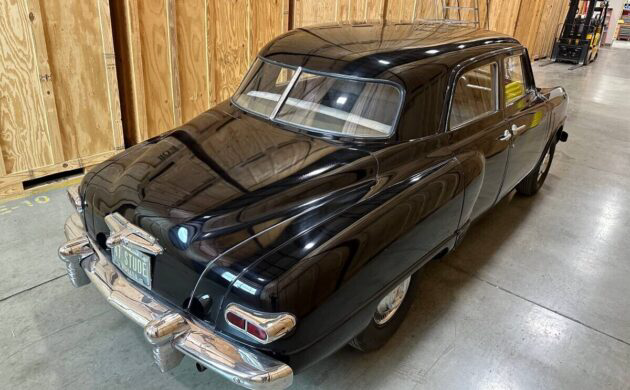
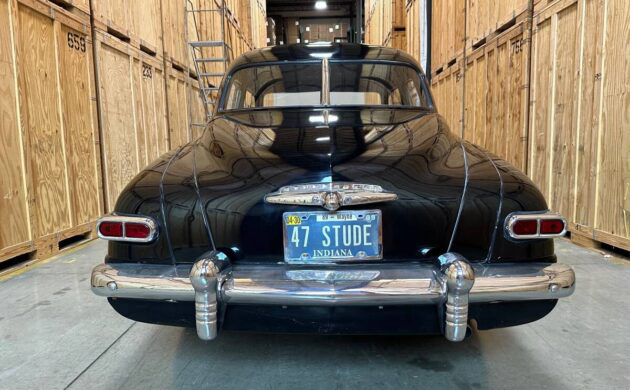
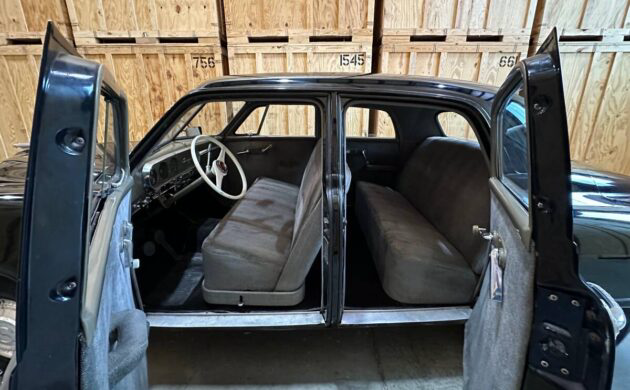
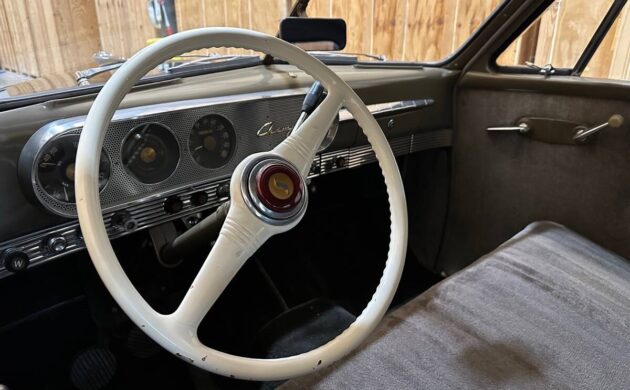
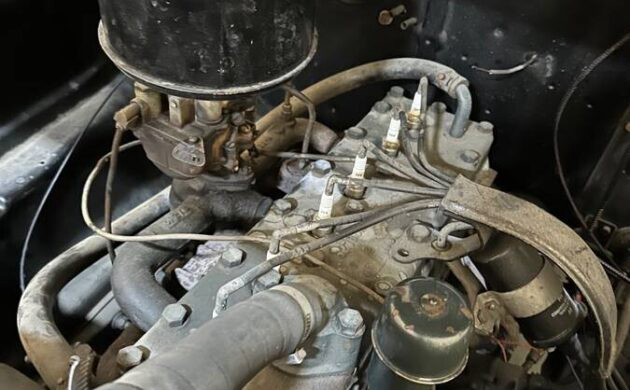


I recently found a discussion on those blacklight instrument panels. Florescent paint (NOT radium!) on the dials and a thick plastic UV filter on the dashboard light. Since the paint slowly loses luminosity with age, apparently the go-to for the original effect is replacing the light and filter lens with a UV LED.
When is the last time I saw one at a car show? Probably never. And thus my take on this car: it’s not the kind of car I would buy, but for this price what else could you buy that is this interesting and in this condition?
My dad’s first car was a ’47 Champion 2 dr sedan. He said that it was hard to keep the front end aligned. I remember that it had armrests in the back that hinged up for storage inside. He messed up the engine one winter trying to get unstuck when the motor was still cold.
Ours was a “51 Cahamp – good family car post-war. Studies were ahead of their time but ultimately too small to compete with the Big 3. (I recall the ‘hill-holder’ brake! Useful as we lived in a VERY hilly town (Dubuque, IA)
Now I remember my dad talking about the hill holder, he was excited about it too. My dad was from Blakesburg, IA. He said that the population was 400, it always stayed at 400 because every time a woman got in trouble, a man left town.
The early years of this body style still used the “Planar” suspension with the transverse leaf spring. They changed to an upper/lower control arm/king pin setup with front coil springs in either ’50 or ’51. Not sure if the earlier design was harder to keep aligned compared to the updated suspension. That later suspension was carried through to the end of production and even lived on in Avanti IIs well into the ’80s (LONG after ball joints became the norm).
“It reminds me of the wooden crate warehouse scene at the end of Raiders of the Lost Ark.”
My exact thought as soon as I saw the first pic. Interesting car too.
This is the car Iggy Wiggum and many other GIs dreamed about upon return. You know, with the little fan on the dashboard? There’s no coincidence, the car had war overtones. The rear glass was similar to a gunner cockpit, and Studebaker was on its “high horse” because of its war efforts. That faded pretty quick once the “others” gained steam again, and the poor little Studebaker became someones $50 back row beater.
In case some may not know where the term “suicide doors” came from, it was alleged, gangsters would “take you for a ride”, tie you to the rear door at speed, and hit the door latch, sending you, and the door, to kingdom come. A more plausible explanation, was for rear occupants, they were just downright dangerous, restraints not being implemented yet. I read, this car cost $1535 new, and $200 more than the Ford or Chevy, no doubt limiting sales some. Sadly, Studebaker fell off the charts pretty quick, and never regained their former “glory”, but like Rambler, I bet the folks of South Bend were mighty proud of these cars, and rightly so.
2 memories this re awakens. First, high school friend’s mom had one of these, only without paint. All rust, but what’s that called now? Patera? I worked at a gas station after school and she would come in for 50 cents of gas twice a week like clockwork. Don’t think the car left the city limits (town of 8000) all the time she owned it. This gives me a reason to contact him and see if she was probably buried in it. The other is a Candy Apple Red restorod that my building contractor had. Beautiful with the factory sunvisor and chrome wheels and side pipes. He put spark plugs in the pipes and would wind engine up and kill ignition, activating the exhaust spark plugs. Shot flames out about 2′. About like the ’49 Merc in Gone in 60 Seconds. He retired 10+ years ago, think need to look him up and see if wants to part ways with it.
Automakers were barred from working on postwar designs during WWII. Studebaker found a loophole in that they used an outside design firm, Raymond Loewy Associates, which was not subject to the war restrictions. It wasn’t really the advantage Studebaker thought it would be, however, because automakers could sell *anything* to the car-starved public in the late 1940s, making Studebaker’s all-new cars unnecessary. By the time the “Big 3” caught up with new postwar designs, Studebaker’s cars were old news.
The Steadybraker, strange then and strange now. Love those suicide doors.
Yes the famous “hill-holder’ brake (as a kid, my folks had a President “54-60)
I didn’t think of Raiders of the Lost Ark. I immediately thought of the Muppet Movie. “A bear in his natural habitat. A Studebaker.”
Same here!
Movin’ right alooooong
I saw a Champion in scrap yard 40 years ago .The yard was visible from the Ross Spur road.The car was in a shed, with a Morris Minor.Car no 86 so first days production.The Studebaker looked rock solid. Out in the yard were two American lorries they survived so did the Champion? Can someone say.